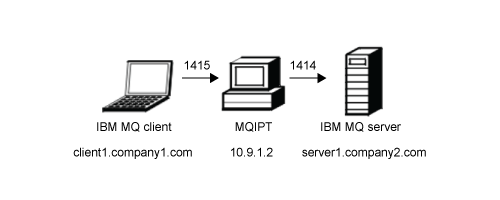Running MQIPT in TLS proxy mode with a security manager
We can run MQIPT in TLS proxy mode, so that it accepts a TLS connection request from an IBM MQ TLS client and tunnels it to a IBM MQ TLS server. By using a security manager with MQIPT, we can restrict the addresses to which messages can be sent.
Before starting
Before you start to use this scenario, make sure that we have completed the prerequisite tasks listed in Getting started with IBM MQ Internet Pass-Thru.

This diagram shows the connection flow from the IBM MQ client (client1.company1.com on port 1415) through MQIPT to the IBM MQ server (server1.company2.com on port 1414).
For further information on configuring TLS for IBM MQ, refer to Work with SSL/TLS.
Procedure
To run MQIPT in TLS proxy mode with a security manager, complete the following steps:
- Configure the IBM MQ client and
server to use a TLS connection.
- Create a key repository for the queue manager. For more information, see Set up a key repository on UNIX, Linux, and Windows.
- Create a key repository for the client in the C:\ProgramData\IBM\MQ directory. Call it clientkey.kdb.
- Create a personal certificate for the queue manager, in the queue manager key repository that you created in step 1.a. For more information, see Create a self-signed personal certificate on UNIX, Linux, and Windows.
- Create a personal certificate for the client, in the client key repository that you created in step 1.b.
- Extract the personal certificate from the server key repository and add it to the client repository. For more information, see Extracting the public part of a self-signed certificate from a key repository on UNIX, Linux, and Windows, and Adding a CA certificate (or the public part of a self-signed certificate) into a key repository, on UNIX, Linux or Windows systems.
- Extract the personal certificate from the client key repository and add it to the server key repository.
- Alter the MQIPT.CONN.CHANNEL server connection channel to use TLS by using the MQSC
command:
ALTER CHANNEL(MQIPT.CONN.CHANNEL) CHLTYPE(SVRCONN) TRPTYPE(TCP) SSLCIPH(TLS_RSA_WITH_AES_128_CBC_SHA256)
-
On the MQIPT computer (see the diagram), copy the
sample Java Security Manager policy to the MQIPT home directory, by entering the following command at a
command prompt:
copy C:\mqipt\samples\mqiptSample.policy C:\mqiptHome\mqipt.policy
- Start the Policy Tool utility by using the following command:
C:\mqipt\java\jre\bin\policytool
In the policy tool:- Click File > Open then select C:\mqiptHome\mqipt.policy..
- Select:
file:/C:/Program Files/IBM/IBM MQ Internet Pass-Thru/lib/com.ibm.mq.ipt.jar
then click Edit Policy Entry - Change CodeBase from:
file:/C:/Program Files/IBM/IBM MQ Internet Pass-Thru/lib/com.ibm.mq.ipt.jar
to:file:/C:/mqipt/lib/com.ibm.mq.ipt.jar
-
Change the file permissions for the IBM MQ Internet Pass-Thru,
errors and logs directories from:
C:\Program Files\IBM\IBM MQ Internet Pass-Thru
to:C:\mqiptHome
-
Change the other file permissions from:
C:\Program Files\IBM\IBM MQ Internet Pass-Thru
to:C:\mqipt
- Click Add Permission Complete the fields as follows:
Permission: java.net.SocketPermission
Target: client1.company1.com:1024-
Actions: accept, listen, resolve - Click File > Save to save the changes to the policy file.
- Edit mqipt.conf. Add the following properties to the
[global] section and add the following route definition:
[global] SecurityManager=true SecurityManagerPolicy=C:\mqiptHome\mqipt.policy [route] ListenerPort=1415 Destination=server1.company2.com DestinationPort=1414 SSLProxyMode=true
- Start MQIPT.
Open a command prompt, and enter the following command:
C:\mqipt\bin\mqipt C:\mqiptHome -n ipt1
where C:\mqiptHome indicates the location of the MQIPT configuration file, mqipt.conf, and ipt1 is the name to be given to the instance of MQIPT. The following messages indicate that MQIPT has started successfully:5724-H72 (C) Copyright IBM Corp. 2000, 2020 All Rights Reserved MQCPI001 IBM MQ Internet Pass-Thru V9.2.0.0 starting MQCPI004 Reading configuration information from mqipt.conf MQCPI152 MQIPT name is ipt1 MQCPI055 Setting the java.security.policy to C:\mqiptHome\mqipt.policy MQCPI053 Starting the Java Security Manager MQCPI021 Password checking has been enabled on the command port MQCPI011 The path C:\mqiptHome\mqipt\logs will be used to store the log files MQCPI006 Route 1415 has started and will forward messages to : MQCPI034 ....server1.company2.com(1414) MQCPI035 ....using SSLProxyMode protocol MQCPI078 Route 1415 ready for connection requests
- At a command prompt on the IBM MQ client
system, enter the following command to run the TLS sample program:
AMQSSSLC -m MQIPT.QM1 -c MQIPT.CONN.CHANNEL -x 10.9.1.2(1415) -k "C:\ProgramData\IBM\MQ\clientkey" -l cert_label -s TLS_RSA_WITH_AES_128_CBC_SHA256where cert_label is the label of the client certificate that you created in step 1.d.
Parent topic: Getting started with IBM MQ Internet Pass-Thru